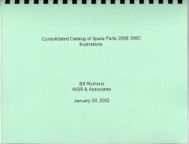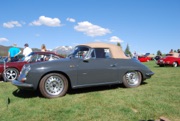Study of Porsche’s Catalog of Spare Parts 356B and Supplements and Presentation of a Consolidated Catalog of Spare Parts 356B 356C


AUTHOR Romano/Factory
ENGLISH / CD
ISBN 10 NO ISBN 10
ISBN 13 NO ISBN 13
First manual is
$25.00
Additional manuals ordered at same time are $15.00
356 A Catalog of Spare Parts (not consolidated)
B-C Workshop Manual
Carrera Assembly Guide
Factory Photos
356 spec book
All are sent electronically (no shipping charge)
Please contact me directly.
AVAILABLE FROM BLOCKS BOOKS
From my review in the 356 REGISTRY:
Bill Romano’s Study of Porsche’s Catalog of Spare Parts 356B and Supplements and Presentation of a Consolidated Catalog of Spare Parts 356B 356C is nothing less than the 356B-T5, T6/C and C Parts Catalogs combined and reorganized. By eliminating the German and French translations the size of the catalogs is cut by 2/3rds; melding the three volumes results in a single set of two books – one illustrations and one the Consolidated Catalog. Even further the origin and development of a given part may be followed without paging through several manuals. This has been taken to such a degree that in Bill’s Study a part is identified by: Gr (group) – the same as the original catalog, IL (illustration) – also keyed to the original catalog, Ca (catalog) – in exactly which catalog or supplement the part appeared, pg (page) – on which page the part appeared in the factory catalog, s (inserted page) – documenting the part’s presence on an inserted page [such as 8a between pages 8 and 9), rev (revision) – revision number [there are 29 revisions among the 3 catalogs], rev date (revision date) – self explanatory, ln (line) – number of line upon which the original part is listed on the referenced page in the factory catalog, Ref No – the number identifying the part on the illustration page. Then we get to Bill’s MAGIC Sync number, which references the initial appearance of a part or a superseded part. This allows tracking of the entire sequence of a part’s development and the relationship of functionally similar but non-interchangeable parts. The sync number becomes extremely complex since it has embedded reference to the original part appearance, assemblies and sub-assemblies, part’s first appearance, even parts absent from the illustration or catalog. I am still not completely clear how this works. Especially when I see an example of an Zenith Air Filter Can with the sync number of “3(1/7-(23)).” All of this is followed by columns for the factory part number, generic part number (usually bolts M 8 ect.), DIN part number, factory catalog description, and columns for normal, S, S-90, C, SC with how many are needed and finally remarks – usually pertinent to specific car, such as the Carrera 2, beginning or ending chassis numbers. There are multiple appendices including translations: St. = steel, verz. = verzinkt, galvanized St verz = galvanized steel. It should have occurred to those of you who have not been paralyzed by the foregoing that all of this lends itself to computerization. Indeed, searching the illustrations (and the few, but-to-be-added-to photographs) and the Study is easier than flipping pages – IF you have at least a 17” monitor and a really fast chip. The Study is in Word and the illustrations are in PowerPoint. As a corollary the files are huge, thus taking time to search. Not yet present, but and obvious future enhancement would be hyperlinks between the illustrations and the catalog. Since the catalog is in Word, it may be (purposely or in my case inadvertently) edited – this of course has no effect on the CD-ROM. The data needs a little cleaning, in that I found a few errors. For most of us, the parts numbers themselves, much less, the supersession of parts numbers, are irrelevant, and Charlie White’s reprints of the pictures suffices. However, if you need to know what part superseded what and when, Bill has the only game in town. There is an immense amount of work here, but it still a work in progress. Perhaps will would provide updates at a discount to buyers. Bill is convinced that the CD-ROM version is much more useful than the paper version and offers it @ $35.00. If you must have paper, buy the CD-ROM version and print your own, at which time you will realize why the paper version costs $75.00.
Bill Romano has gone to an immense effort providing us with his B-C Consolidated Catalog or more precisely catalogs, since they are readable as PDF or Microsoft Office (PowerPoint) files. Either have the Consolidated Factory Parts Manual Illustrations and Consolidated Parts Manual list of parts numbers. The PDF files also have supplemental Illustrations/photographs. Both the PowerPoint and PDF versions have along the left margin “thumbnail” views of the Illustrations permitting the user to scan for the page of interest – by opening the PowerPoint ‘Slide Sorter View’ with up to 16 pages per screen, or the PDF “Pages” tab on left side. In PowerPoint, double clicking on the small image opens the page screen. Having identified the part of interest on the illustration page; go to the Word or PDF Parts List (Porsche part numbers & number needed). In Word use the scroll bar to find the page in the Parts List matching the Group/Illustration number of the selected part -- the Word document shows a small page title window that makes this easier. It’s fairly easy to stop in close proximity to the desired page and then page up or down to the start of the desired page. In PDF use the bookmarks. You then scan using the ‘sync no.’ or ‘fig. no.’ from the Illustration to find the description and part number of the desired part and the history of changes that have occurred..
The consolidated part means you can trace a given part’s development forward and backward in time. If a number of a part on the illustration page is identical on each of the three manuals you can use the “fig. no” but if its number changed Bill has provided a “sync no.” As with the printed manuals, you would look though which of the three manuals (original 356B-T5 Parts Manual 1960-1961, 356B-T6 supplement, or 356C supplement) to find the picture of the part in question. You then go to the Parts List to find the part number. The magic is that parts illustration pages come one after another; you are only looking through one manual – it’s a real pain to look in the C Parts Manual only to find that the part hasn’t changed and need to go to the B-T6 Pats Manual or perhaps even the original book. A bonus is the ability to trace the evolution of a given part.
Bill has now expanded his offerings with 356A Catalog, 356B-C Catalog, B-C Workshop Manual, Carrera Assembly Guide, Specs book – these are straight copies of the Porsche Factory Manuals. You no longer need to slip the pages you are using through the company copier, or avoid getting greasy fingerprints on your astoundingly expensive manuals – just print the pages from your computer. The Specs book will is obviously no longer small and pocket sized but in recompense the words and numbers are large enough to be readable. Finally, Factory Photos – taken by Bill and his brother in the 356B-T6 period (sort of a 1962 version of Tony Singer’s Factory tour 1960 – only virtual). Many of the photos show something new – I was unaware that 356B-T6 transmissions appear to have cadmium plated, not black oxidized fasteners. Bill sells the consolidated B-C Parts catalog at $25.00 and each additional bit at $15.00 plus $5.00 shipping in the US. Order from Bill Romano at 51 Duck Cove Cir. Berlin, MD 21811 or wsr6@mchsi.com or Blocks Books.

